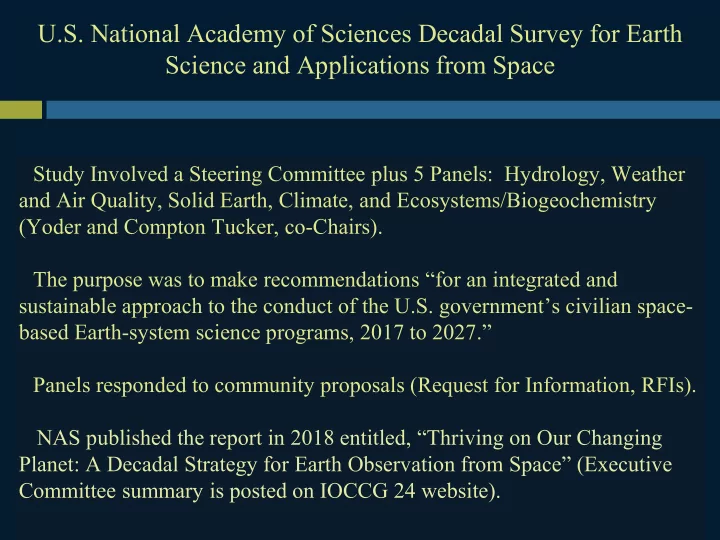

U.S. National Academy of Sciences Decadal Survey for Earth Science and Applications from Space Study Involved a Steering Committee plus 5 Panels: Hydrology, Weather and Air Quality, Solid Earth, Climate, and Ecosystems/Biogeochemistry (Yoder and Compton Tucker, co-Chairs). The purpose was to make recommendations “for an integrated and sustainable approach to the conduct of the U.S. government’s civilian space- based Earth-system science programs, 2017 to 2027.” Panels responded to community proposals (Request for Information, RFIs). NAS published the report in 2018 entitled, “Thriving on Our Changing Planet: A Decadal Strategy for Earth Observation from Space” (Executive Committee summary is posted on IOCCG 24 website). 1 2012
Based on Science Questions, Ecosystem Panel Recommended the Following Ocean Missions/Measurements 1. Space-borne Ocean Lidar (532 and 355 nm). Aircraft and CALIOP heritage. 2. Hyperspectral and 30-m pixel resolution polar orbiting imager. Example: HyspIRI 3. Radiometry from geostationary orbit (like GOCI, proposed NASA GEO-CAPE) . 4. ACE. PACE is one model. **Ecosystem Panel rated (1) as a highest ocean priority and (2) as a highest land/ocean priority.** 2 2012
Steering Committee (SC) Report Was Most Important. Below are Top Rated Science Priorities . SC “Most Important” Science Theme Water and Energy Cycles; Weather and Air Quality Forecasts; Reducing Climate Uncertainty and Informing Societal Response; Surface Dynamics, Geological Hazards, and Disasters; and Ecosystem Change Ecosystem changes in time and space? Fuxes (of carbon, water, nutrients, and energy) between ecosystems and the atmosphere, the ocean, and the solid Earth and within ecosystems. How and why are they changing? See next slide for SC “Observing System Priorities” 3 2012
Observable Science Application Candidate Measurement Aerosols Aerosol properties and profiles, Backscatter lidar and cloud properties. NO OCEAN multichannel/multiangle/po application listed; both need larization imaging 532nm. radiometer. Surface Biology and Ground water temp, snow, Hyperspectral imagery in Geology. geological processes, vegetation vis/shortwave IR , multi- or and algal biomass. hyperspectral imagery in the therm. IR. Greenhouse Gases. CO2 and methane fluxes and Multispectral shortwave IR trends. and thermal IR sounders or lidar. Snow depth and snow Incl. high resolution in mountain Radar altimeter or lidar. water. areas. Terrestrial ecosystem Forest canopy, biomass, carbon Lidar struture. stock and forest degradation. Atmosphere winds. Transport, wind energy, cloud Lidar, radar or dynamics and large-circulation. scatterometry. 4 2012
Proof of Concept for Ocean Lidar • CALIOP lidar on CALIPSO (in the A-train) • High Spectral Resolution Lidar (HSRL) on aircraft that provides vertically-resolved aerosol size, concentration and composition, plus ocean particle profiles. Two key wavelengths: 355 and 532 nm (to separate particles from molecules). 3 optical depth penetration. 5 2012
Ocean C biomass from the CALIOP Lidar Compared to MODIS (from Behrenfeld et al. 2016) 6 2012
Why Lidar? Retrieve Ocean Particulate C at Low Sun Angles (no radiometry). From Behrenfeld, 2016. Nine year time series (black lines and black dots) of phytoplankton carbon based on CALIOP lidar backscatter at 532 nm. 7 2012
Aircraft HSRL example showing aerosols and ocean particle backscatter (for calculating ocean particulate C). (From Hostetler et al. RFI: aircraft data from SABOR experiment) 8 2012
Conclusions and Comments regarding NAS report 1. Good News! Hyperspectral and high spatial resolution imagery as a high priority is good news! However, the involvement of multiple science communities could lead to conflicts on instrument specifications. 2. Bad News! No ocean biology priority for lidar. Ocean biologists will have to aggressively engage at planning workshops to win a seat at the table for planning lidar “aerosol” mission. Comment: Could IOCCG help convince NASA to include ocean biology when planning what is currently a lidar aerosol mission? Ask Paula. 9 2012
Recommend
More recommend